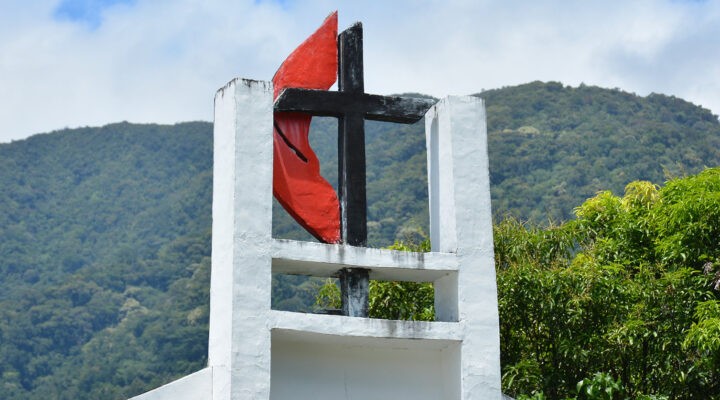For the first time in half a century, acceptance of sexual minorities isn’t likely to be the major issue coming before The United Methodist Church’s worldwide legislative assembly next spring. Instead, the looming political fight appears to be how to realign the structure and authority of the UMC by reorganizing the global denomination into roughly continental regions, including the United States.
The move to “regionalization,” as it’s known, emerged in December 2019 as a reaction to a privately negotiated plan to divide the UMC, known as the “Protocol of Reconciliation and Grace through Separation.” Instead of signing on to the protocol, an ad hoc group of United Methodists outside the United States drafted what they called the “Christmas Covenant.” The two approaches were set to collide at the 2020 General Conference, the UMC’s top legislative assembly.
Then the coronavirus pandemic hit, and General Conference was postponed three times as the COVID-19 plague curtailed travel around the globe. Over the past four years, momentum for the protocol waned, in part because dissident forces, angered by General Conference delays that stalled a protocol vote, established the Global Methodist Church in May 2022. The new church’s creation sparked a wave of church departures known as “disaffiliation” under a special provision that expires Dec. 31, 2023.
7,000 disaffiliations in U.S.
Thus far, nearly 7,000 local churches out of 30,000 U.S. congregations have left the denomination under the special provision known as Paragraph 2553. The departures have been acrimonious in many cases, with coalitions of churches attempting to avoid 2553’s “exit fees” and retain their church property by filing civil lawsuits against their regional units known as annual conferences.
“Nearly 7,000 local churches out of 30,000 U.S. congregations have left the denomination.”
According to United Methodist law, all church property is held “in trust” for the annual conference, considered the UMC’s basic organizational unit.
In most cases, the “trust clause,” as it’s known, has weathered civil court challenges well, with most judges citing separation of church and state in ruling against local churches. In one of the most recent cases in Oklahoma, the dispute went all the way to the state Supreme Court before justices ruled the civil authority had no jurisdiction over church matters. In early November, an Alabama judge dismissed the civil suit of a church in which members demanded the right to vote on disaffiliation, saying he did so to give the plaintiffs the opportunity to appeal their case to that state’s Supreme Court.
For and against regionalization
Political forces on both sides of the issue have long since issued their respective propaganda around regionalization.
One movement, Mainstream UMC, which bills itself as representing the “centrist” position, went so far as to publicize a strategy for getting regionalization adopted by the 2024 General Conference, which will meet April 23-May 3 in Charlotte, N.C.
In the opposing camp, Good News, a longtime conservative association, has refuted Mainstream UMC’s arguments by raising an old bugbear — the idea that regionalization is merely a back-door tactic to allow removal of the UMC’s historic doctrine that homosexuality (not the full range of LGBTQ sexuality) is “incompatible with Christian teaching.”
Loosening U.S. influence
The conservative viewpoint may be partly right, as even Mainstream UMC’s executive director Mark Holland concedes. Yet that’s not the only reason the idea of regionalization has taken hold. For those outside the United States, the impetus for regionalization isn’t human sexuality, but to loosen the U.S. church’s grip on the international denomination.
“For those outside the United States, the impetus for regionalization is to loosen the U.S. church’s grip on the international denomination.”
U.S. United Methodists have dominated churchwide politics since the denomination was founded in 1968 through the merger of the historically English-speaking Methodist Church and an originally German-speaking cohort that became the Evangelical United Brethren Church. As the UMC continued through the latter half of the 20th century, membership grew internationally while it declined in the United States. Yet U.S. delegates to the General Conference continued to maintain power, partly through the calculus by which delegate numbers are allotted and then through U.S.-centric church policies and procedures.
However, a “sleeping giant” provision of the United Methodist constitution lurked. Bearing an unfortunate name that harked back to the racially segregated U.S. Central Jurisdiction that existed from 1939 to 1968, non-“Central Conferences” had the authority to adapt the Book of Discipline to fit their cultural contexts, provided those adaptations didn’t violate the constitution and other inviolable doctrines known as the “restrictive rules.”
Sketchy application proved a problem with this provision. Rather than non-U.S. regions widely claiming a unifying power to craft their own church laws, application occurred piecemeal. Non-U.S. contextualization occurred frequently under the radar of U.S. church political factions except when needed for General Conference votes (a reality seen by international United Methodists as evidence of the UMC’s colonialism).
Because policies such as the ban on ordaining “homosexual” (again not LGBTQ) clergy applied to the entire church, the General Conference faced continual battles over human sexuality since 1972. In addition, policies such as the Social Principles, a collection of guidelines for living out Christianity in human society, often focused on issues such as war and peace, nuclear arms, economics, parenting, domestic violence — and yes, human sexuality including marriage and women’s rights — solely from a U.S. perspective.
Two protocols
According to those knowledgeable about the background of the original Christmas Covenant, the Protocol for Reconciliation and Grace through Separation laid the last straw on the camel of growing international discontent with U.S. governance. Although the protocol’s negotiations were initiated by the late Bishop John Yambasu of Sierra Leone, its discussions were quickly taken over by representatives of U.S. political groups and the Council of Bishops.
The lack of more grassroots international representatives in the protocol talks affronted non-U.S. United Methodists. Many wanted to stay in the UMC while some didn’t, but they resented not being included in the talks about whether and how to break up what was then a nearly 13-million worldwide denomination. Hence the Christmas Covenant began as a unity movement.
Since December 2019, when both the protocol and the Christmas Covenant were announced, regionalization gained more institutional support. The Connectional Table, the UMC’s ministry coordinating body, embraced the Christmas Covenant as a reflection of its own prior efforts at granting more autonomy for international United Methodists. Working with Christmas Covenant representatives, the Connectional Table drafted legislation for General Conference to enact regionalization. Subsequently, that proposal was reworked with the help of General Conference’s Standing Committee on Central Conference Matters, a subgroup instituted in the early 21st century to try to bring more equality to the top legislative body.
This won’t be easy
Moving to regionalization won’t be simple or easy. It requires amending the United Methodist Church’s constitution, first by a two-thirds vote of the General Conference, followed by ratification by two-thirds votes in at least two-thirds of the annual conferences around the world.
“The movement to remove the U.S. church from the center of United Methodist authority ranks highly among pending issues.”
Despite such requirements, the movement to remove the U.S. church from the center of United Methodist authority ranks highly among pending issues. Although the protocol is officially on the legislative docket, it’s all but dead politically because too much time has passed and too many things have changed since it was first proposed. Among those changes has been the wave of disaffiliations sparked by founding the Global Methodist Church, a dissident body organized by U.S. “traditionalists” in May 2022.
In other words, the protocol isn’t needed any longer, because separation has happened independently, aided by the disaffiliation process established by the special called 2019 General Conference.
Losses on all sides
The U.S. church isn’t the only loser in this movement; traditionalist forces also have lost a $25 million “seed fund” that was earmarked in the protocol to start a more conservative Methodist church. Instead, the Global Methodist Church has set itself up as the “Transitional Leadership Council of the Global Methodist Church” based in Fredericksburg, Va. Thus far it hasn’t filed an IRS Form 990 disclosing its income as a 501(c)(3) religious body.
While some diehard conservatives are still pushing for adopting the protocol and its seed money — which would be even more difficult for the UMC to provide having lost 7,000 local churches — regionalization appears to have enormous appeal. Non-U.S. United Methodists want enough autonomy to decide how they will live out their Wesleyan heritage within their own cultural contexts without being constrained by the U.S. church.
For example, in Africa the church must contend with a longstanding cultural practice of polygamy among its human sexuality concerns, which often aren’t discussed openly because of taboos. In Europe, the specter of Russian aggression hangs over both church and society. In the Philippines, the church faces an oppressive government, economic problems, and Islamist incursions.
Issues crucial to their respective regions are peripheral to the U.S. part of the UMC, which is struggling to remake itself in the wake of disaffiliations. That loss impacts the church’s income and its political clout, since membership totals determine the number of each annual conference’s General Conference delegates.
With United Methodist membership growing outside the U.S., especially in Africa, the 2024 General Conference poses a crucial juncture for U.S. interests while its delegates still comprise between 55% and 60% of the General Conference. Plus, in 2024, U.S. delegations to General Conference will be made up of mostly progressive clergy and laity elected in 2019 in rejection of tightened anti-gay rules.
“The world has changed drastically since the 2019 General Conference.”
Moreover, the world has changed drastically since the 2019 General Conference when “traditionalist” delegates, aided by Africans and Eastern Europeans, enacted draconian penalties against anyone who violated the UMC’s homosexuality bans. Starting in 2020, the coronavirus pandemic, with its high death toll and mandatory lockdowns that disrupted economies and societies, served further to fracture the denomination.
Loyal United Methodists, still in love with their Wesleyan heritage, want to #BeUMC as the slogan goes. Nonetheless they see the need to make their denomination more flexible to adapt to a world changing with each nanosecond.
Regionalization now bears a beneficent aura as a primary tool for creating equity in UMC governance and contextual flexibility in ministry. Come spring, United Methodists will decide whether the tool will be put to use.
Cynthia B. Astle is a veteran journalist who has covered the worldwide United Methodist Church at all levels for more than 30 years. She serves as editor of United Methodist Insight, an online journal she founded in 2011.


